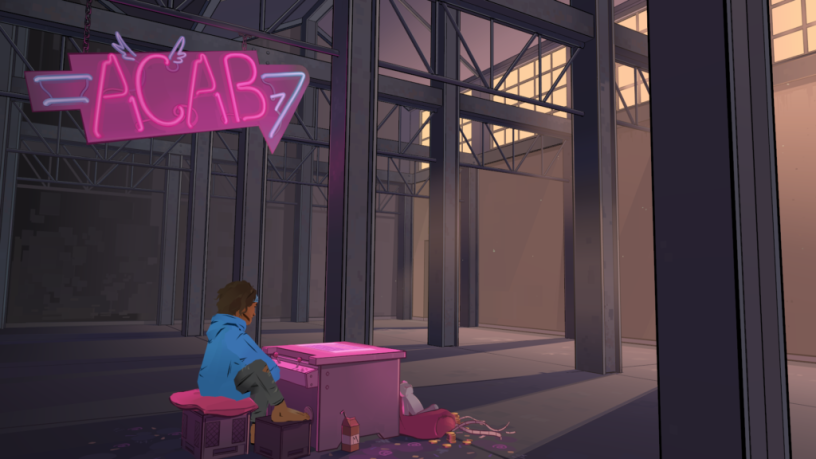In partnership with Polygon Studios, XR studio New Canvas has launched non-fungible tokens (NFTs) based on its project Lustration, currently playing in Venice Immersive.
The company hopes NFTs may offer a new business model that can help build a creatively and commercially-engaged community around its properties, and allow it to commercially reward creators and artists for their contributions throughout the entire lifespan of a project.
Created, written and directed by Ryan Griffen, Lustration VR takes audiences to ‘The Between’, a world after death. It follows Bardolph and Gallus, two protectors of the afterlife, upholding good against evil by removing those who do not belong.
However, when they miss removing someone, they begin to uncover the truth about The Between; that it is run like an elite country club, with the powers-that-be picking and choosing who gets eternal happiness and who doesn’t.
Each of the four episodes are told from different characters’ perspectives and can be experienced from different vantage points.
The voice cast includes Kevin Conroy, Grey Griffin, Dante Basco, Tamlyn Tomita, Shakira Clanton, Kelton Pell and Hunter-Page Lochard.
Taryne Laffar and Carolina Sorensen produced, with New Canvas CEO Nathan Anderson executive producer along with Griffen, Wolfgang Bylsma, and Conroy.
Commissioned by Meta, Lustration VR is just one of two Aussie projects, alongside Peter Hegedus’ Sorella’s Story, to be showcased in the Venice Immersive section of the Venice Film Festival. It screens out of competition in the ‘Best of’ strand, having already premiered earlier this year at SXSW and available via Meta.
The first phase of Lustration’s NFT strategy involves release of a limited set of one-to-one artworks from season one. Each unique piece features a character within a scene, and is designed to be collectible. Further, all pieces will unlock access to digital comics of the series and exclusive community channels on New Canvas’ Discord.
Future NFT phases will include entirely new characters from ‘The Between’.
New Canvas is also minting a social token that is currently available for pre-sale and will be made available to the public in 2023.
Lustration VR is New Canvas’ first project since its official launch in December 2020; CEO Nathan Anderson spun the company out of Start Beyond.
Anderson tells IF it has been looking into Web3 and the potential of NFTs/tokens for 12 months now, inspired by projects such as Stoner Cats, which used NFTs to raise its entire $US5 million+ production budget.
“We see NFTs and social tokens as a new model for audience engagement that brings together the best aspects of transmedia, loyalty programs and crowdfunding. When done right, this offers a true community approach that motivates involvement, creatively and commercially,” he says.
For Anderson, the token approach, developed in partnership with Polygon Studios’ head of Metaverse Brian Trunzo, allows New Canvas to value creatives and artists in new ways.
Specifically, it will share the profits from the NFT revenue with artists 50/50; so .50c of every dollar will go to the rights holders/key stakeholders and the other .50c to the artists that made the specific work.
“We want to make it clear, this is not another avenue for rights holders to exploit IP without the inclusion or involvement of the artists that helped to make it,” Anderson says.
“This artist royalty changes depending on the specific work but for this first release that has been rendered from our VR scenes, it includes the lead VR artist, the environment VR artist, the concept artist(s) and even the NFT capture artist (who framed the NFT shot from the VR scene).
“It is important to note that this is over and above any contracted fees paid to these artists as part of their production agreement to make the work. The great thing is that this can all be done programmatically (through the blockchain) with smart contracts so royalties are paid instantly to the artists’ digital wallets. There are so many opportunities for this sort of thing to totally revolutionize the residuals and royalties model for artists – it is very exciting stuff!”
New Canvas co-founder and chief strategy officer Wadooah Wali adds that transparency is the promise of Web3, and the blockchain makes it possible, which is why it appealed as a new business model.
“We saw it as an opportunity for us to be bold – not only being vocal about wanting the rights of artists and creators to be protected and compensated, but to actually put intentions into action,” she tells IF.
“When we’re talking about being unapologetic in our desire to bring diversity, equity, inclusivity and belonging to the Metaverse, it’s about all aspects of the ‘people’ part of the equation, from monetisation to representation, which ultimately is in the DNA of New Canvas.”
Venice Immersive programmer Liz Rosenthal says Lustration is an exceptional example of immersive storytelling, and is interested to see Web3 systems like NFTs open up potential new business models.
“As the creative language of immersive art and storytelling rapidly evolves, the business models around these new mediums is nascent and XR creators have limited routes to finance and for revenue generation,” she says.
” A whole new ecosystem around decentralised systems will offer a creators powerful new ways to build new relationships and financing opportunities with audiences and investors and the makers of Lustration are paving the way for other XR creators to explore new routes to sustainability.”


